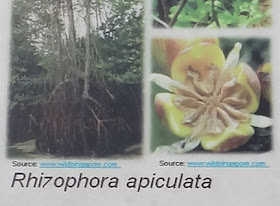I saw these and other exciting mangrove plants at the delightful Punggol Promenade Riverside Walk.
The last Pisang-pisang, a Critically Endangered plant, was seen on the mainland at Pasir Ris and lost in 2011. These replanted seedlings came from Tekong! The netting is part of the planting process to protect the young plants.
I saw another special plant that I've not seen in the wild yet -- Rapanea porteriana.
It's not easy to spot the trees as the Sea morning glory (Ipomoea pes-caprae) have been allowed to grow among them. But the trees are doing quite well!
The Rhizophora babies have grown very well, with large well-formed leaves. A few have put out stilt roots too!
The Teruntum Merah (Lumnitzera littorea) are quite tall with lots of fresh green leaves!
Here's another view of the elegant walkways with mangroves planted around the water margins. The mangroves are planted along this lovely winding boardwalk, which allows a closer look at these amazing plants. Once they grow up in a year or two, it will surely be a great place for people to appreciate and learn more about our mangroves.
Some of the young trees still have their labels on them.
Another view with some taller planted trees sticking out more obviously.
Among some of the exciting plants I saw were flowering Tumu Berau (Bruguiera sexangula), pretty flowering, lots of baby Nipah palms (Nypa fruticans), and of course, the ever lovely blossoms of the Sea Holly or Jeruju (Acanthus sp.). You can buy native mangrove and other plants from Uvaria Tide.
There's lots of signs with information and photos of the many different kinds of mangroves that have been planted there.
I didn't realise until it was pointed out to me, that the photos were mine and taken from the wildsingapore website! It was nice of them to add a link to the site!
There are also other signs pointing out some of the birds and other wildlife that people can look out for in the area.
It was nice to see a school group doing some outdoor work here, learning more about our biodiversity despite the scorching heat.
I saw three men at the walkway who trampled on the plants to get to the water's edge and lay fishing lines.
There is a bridge across the Serangoon River, which has been dammed to create a reservoir.
This leads to the Lorong Halus Wetland. Lorong Halus was Singapore's last landfill before it was closed many years ago. Buried beneath the serene vegetation is rotting garbage. This produces icky stuff called leachate.
 |
| Click on image for larger view. |
 |
| Click on image for larger view. |
I'm looking forward to returning to check up on how these planted mangroves are doing. Mangroves grow slowly even in the best of conditions, so we need to be patient. But I'm sure in the years ahead, this spot will be a marvellous place to view all kinds of rare and interesting mangrove trees and plants!
After the trip, I spent a lovely evening at the Biodiversity Roundtable, where many key members of the nature community have gathered to discuss issues and learn about the work being done for nature in Singapore.
I particularly enjoyed Uncle Tony's talk about the Swamp Forests of Singapore, which apparently has some weirdos! But seriously, these forests are in grave danger and much work is being done to ensure that they continue to survive. Check out his Flora Singapura site for more amazing photos and stories about our fascinating plants.
Just as with the replanting of mangroves at Lorong Halus, there is consideration for efforts to replant swamp forest plants in some of our more urban areas so that ordinary people can experience and appreciate them. That would be awesome!
Related posts



















